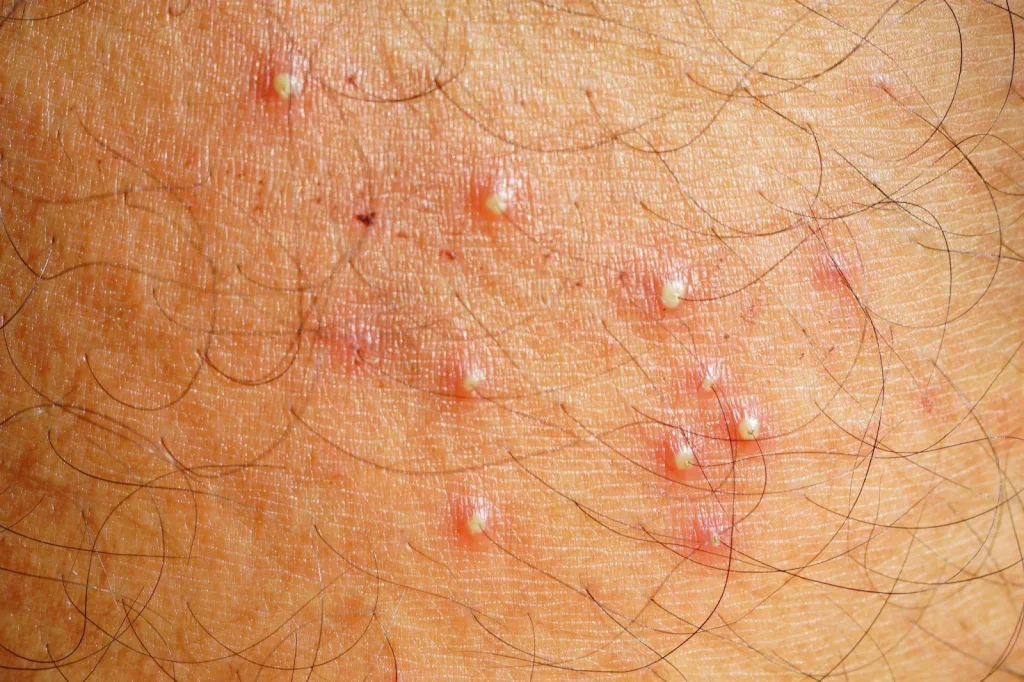by: Trixie Valle-Tin, MD, FPDS
What is Folliculitis?
Folliculitis is an inflammatory process that involves the hair follicle or the pilosebaceous unit. It often manifests with redness, swelling, itching, or tenderness around the follicle and the perifollicular area. Folliculitis usually evolves in appearance and associated symptoms depending on the underlying cause and the depth of involvement. Clinically, it may appear as a dry thickened bump or as a pustule (pus-filled space) in the follicular opening or as a nodule deep in the follicle. It may also be a primary skin condition or as a secondary process in relation to another dermatologic disease. The location and the course of the folliculitis may help your dermatologist in determining the cause of the folliculitis.
What causes folliculitis?
Generally, folliculitis can either be infectious or non-infectious in origin.
Factors that can predispose to bacterial folliculitis include: conditions that lead to occlusion or maceration of the skin and exposure to contaminated surfaces, pre-existing itchy skin diseases that tend to be scratched such as eczema, and practices that may irritate the follicular unit such as improper hair removal. Nasal carriage of Staphylococcus aureus may also lead to repeated folliculitis in a person or his close contacts. Fungal folliculitis may occur with exposure to pets, soil, or another infected person, and usually appears in the setting of scaly red plaques with advancing borders that are typical of fungal infections. Folliculitis can also be seen in conditions of yeast overgrowth. Viral infections, most especially from the herpes virus, can also cause folliculitis and appear as pustular grouped skin lesions that tend to be recurrent in certain locations. A parasitic type of folliculitis may be caused by a mite such as Demodex that usually resides in the hair follicle and the sebaceous glands. When infection is a possible underlying cause of folliculitis, it is worthwhile to ask if the patient is immunosuppressed, or may be taking or applying immune-suppressing medications which may make the skin vulnerable to secondary infection if not taken under supervision of a doctor.
The non-infectious types of folliculitis are many and may be associated with genetics, gender, race and age and may be caused by several factors: stress, sun exposure, nutritional deficiency, hormones, drugs and medications, systemic illnesses such as diabetes or kidney disease, and occupational exposure to certain chemicals of which the most well-known are cutting oil, tar, DDT, and halogenated hydrocarbons. Chronic recurrent folliculitis may result from any of these factors or a combination thereof. Acne is a type of chronic folliculitis and the other conditions that may mimic acne like rosacea, perioral dermatitis, and acneiform eruptions have distinct clinical manifestations that must be differentiated from each other to be addressed appropriately.
How do we manage folliculitis?
The first step in managing folliculitis is to identify what causes it so it can be treated or avoided. Frequently, a thorough history and physical examination may be adequate to guide your board-certified dermatologist in giving the proper treatment. In some cases, certain diagnostic tests such as gram staining, culture, KOH smear, Tzanck smear, serologic tests, PCR, and histopathology may be warranted to arrive at the specific diagnosis.
When caused by infection, the treatment therefore is an antibacterial, antifungal, antiviral, or antiparasitic as deemed appropriate by a dermatologist. Any underlying skin disease such as an eczema or other conditions of impaired skin barrier must be treated as well. When the folliculitis is recurrent, it is important to identify external triggering factors such as occlusion, friction, chemicals, and improper shaving, but also internal and systemic factors such as nutrition, metabolic diseases, hormones, and immunosuppression among others. Regardless, consult with a board-certified dermatologist who can give the appropriate management of folliculitis.
How can we avoid getting folliculitis?
The following tips may help:
- Keep your skin barrier intact and healthy by applying moisturizers, emollients, or humectants and by avoiding harsh chemicals
- Proper hygienic practices such as handwashing and bathing can lessen the transmission of bacteria, fungi, and virus
- Avoid scratching or picking on your skin.
- Avoid occlusive clothing and exposure to chemicals that may predispose to occlusion of the follicular unit. Check possible triggers at home or at work.
- Shave in the direction that the hair grows. This, along with proper moisturization of the skin before and after shaving, can prevent hair from growing in and causing bumps. Discuss with your dermatologist about hair removal options such as laser treatments that can lessen the need for shaving. Also, keep your razors clean and dry and change them as often as needed.
- Eat a well-balanced diet. Fruits and vegetables high in Vitamins A and C can prevent folliculitis. Healthy fats can provide essential fatty acids that keep the skin barrier intact and protein is necessary to repair skin and support healing.
- Consult a board-certified dermatologist. Whether acute or chronic, folliculitis must be given the appropriate treatment to avoid recurrence as much as possible.
REFERENCES:
- Sun, K. L., & Chang, J. M. (2017). Special types of folliculitis which should be differentiated from acne. Dermato-endocrinology, 9(1), e1356519. https://doi.org/10.1080/19381980.2017.1356519
Luelmo-Aguilar, J., & Santandreu, M. S. (2004). Folliculitis: recognition and management. American journal of clinical dermatology, 5(5), 301–310. https://doi.org/10.2165/00128071-200405050-00003




